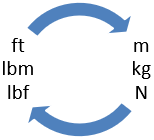Unit Systems
This page provides the chapter on unit systems from the "DOE Fundamentals Handbook: Classical Physics," DOE-HDBK-1010-92, U.S. Department of Energy, June 1992.
Other related chapters from the "DOE Fundamentals Handbook: Classical Physics" can be seen to the right.
Fundamental Dimensions
Length, mass, and time are the three fundamental dimensions on which the measurement of all physical quantities is dependent.
Fundamental Dimensions
Physics is a science based upon exact measurement of physical quantities that are dependent upon three fundamental dimensions. The three fundamental or primary dimensions are mass, length, and time. These three fundamental units must be understood in order to lay the foundation for the many concepts and principles presented in this material.
Mass
Mass is the amount of material present in an object. This measurement describes "how much" material makes up an object. Often, mass and weight are confused as being the same because the units used to describe them are similar. Weight (a derived unit, not a fundamental unit) is a measurement that describes the force of gravity on the "mass" of an object.
Length
Length is the distance between two points. The concept of length is needed to locate the position of a point in space and thereby describe the size of a physical object or system. When measuring a length of pipe, the ends of the pipe are the two points and the distance between the two points is the length. A typical unit used to describe length is the "foot."
Time
Time is the duration between two instants. The measurement of time is described in units of seconds, minutes, or hours.
Units
A number alone is not sufficient to describe a physical quantity. For example, to say that "a pipe must be 4 long to fit" has no meaning unless a unit of measurement for length is also specified. By adding units to the number, it becomes clear, "a pipe must be 4 feet long to fit."
The unit defines the magnitude of a measurement. If we have a measurement of length, the unit used to describe the length could be a foot or yard, each of which describes a different magnitude of length. The importance of specifying the units of a measurement for a number used to describe a physical quantity is doubly emphasized when it is noted that the same physical quantity may be measured using a variety of different units. For example, length may be measured in meters, inches, miles, furlongs, fathoms, kilometers, or a variety of other units.
Units of measurement have been established for use with each of the fundamental dimensions mentioned previously. The following section describes the unit systems in use today and provides examples of units that are used in each system.
Unit Systems
There are two unit systems in use at the present time, English units and International System of Units (SI).
In the United States, the English system is currently used. This system consists of various units for each of the fundamental dimensions or measurements. These units are shown in Table 1.
| Length | Mass | Time |
|---|---|---|
| Inch | Ounce | * Second |
| * Foot | * Pound | Minute |
| Yard | Ton | Hour |
| Mile | Day | |
| Month | ||
| Year | ||
| * Standard unit of measure | ||
The English system is presently used in the field of engineering and throughout the United States. The foot-pound-second (FPS) system is the usual unit system used in the U.S. when dealing with physics.
Over the years there have been movements to standardize units so that all countries, including the United States, will adopt the SI system. The SI system is made up of two related systems, the meter-kilogram-second (MKS) system and the centimeter-gram-second (CGS) system.
The MKS and CGS systems are much simpler to use than the English system because they use a decimal-based system in which prefixes are used to denote powers of ten. For example, one kilometer is 1000 meters, and one centimeter is one one-hundredth of a meter. The English system has odd units of conversion. For example, a mile is 5280 feet, and an inch is one twelfth of a foot.
The MKS system is used primarily for calculations in the field of physics while both the MKS and CGS systems are used in the field of chemistry. The units for each of these systems are shown in Tables 2 and 3 below.
| Length | Mass | Time |
|---|---|---|
| Millimeter | Milligram | * Second |
| * Meter | Gram | Minute |
| Kilometer | * Kilogram | Hour |
| Day | ||
| Month | ||
| Year | ||
| * Standard unit of measure | ||
| Length | Mass | Time |
|---|---|---|
| * Centimeter | Milligram | * Second |
| Meter | * Gram | Minute |
| Kilometer | Kilogram | Hour |
| Day | ||
| Month | ||
| Year | ||
| * Standard unit of measure | ||
The following tables show approximate lengths, masses, and times for some familiar objects or events.
| Object | Length (meters) |
|---|---|
| Diameter of Earth Orbit Around Sun | 2×1011 |
| Football Field | 1×102 |
| Diameter of Dime | 2×10-2 |
| Thickness of Window Pane | 1×10-3 |
| Thickness of Paper | 1×10-4 |
| Object | Mass (kilograms) |
|---|---|
| Earth | 6×1024 |
| House | 2×105 |
| Car | 2×103 |
| Quart of Water | 1 |
| Dime | 3×10-3 |
| Postage Stamp | 5×10-8 |
| Event | Time (seconds) |
|---|---|
| Age of Earth | 2×1017 |
| Human Life Span | 2×109 |
| Earth Rotation Around Sun | 3×107 |
| Earth Rotation Around Axis | 8.64×104 |
| Time Between Heart Beats | 1 |
Derived Measurements
Most physical quantities have units that are combinations of the three fundamental dimensions of length, mass, and time. When these dimensions or measurements are combined, they produce what are referred to as derived units. This means that they have been "derived" from one or more fundamental measurements. These combinations of fundamental measurements can be the combination of the same or different units. The following are examples of various derived units.
Area
Area is the product of two lengths (e.g., width × length for a rectangle); thus, it has the units of length squared, such as square inches (in.2) or square meters (m2).
1 m × 1 m = 1 m2
4 in. × 2 in. = 8 in.2
Volume
Volume is the product of three lengths (e.g., length x width x depth for a rectangular solid); thus, it has the units of length cubed, such as cubic inches (in.3) or cubic meters (m3). The MKS and CGS unit systems have a specific unit for volume called the liter (l). One liter is equal to 1000 cubic centimeters (1 l = 1000 cm3).
2 in. × 3 in. × 5 in. = 30 in.3
Density
Density is a measure of the mass of an object per unit volume; thus, it has units of mass divided by length cubed such as kilograms per cubic meter (kg/m3) or pounds per cubic foot (lbs/ft3).
15 lbs / 5 ft3 = 3 lbs/ft3
Velocity
Velocity is the change in length per unit time; thus, it has units such as kilometers per hour (km/h) or feet per second (ft/s).
Acceleration
Acceleration is a measure of the change in velocity or velocity per unit time; thus, it has units such as centimeters per second per second (cm/s2) or feet per second per second (ft/s2).
Need a Unit Conversion Calculator?
Try this unit converter.
- free-form conversion interface
- tabbed interface for specific units
Unit Conversions
In order to apply measurements from the SI system to the English system, it is necessary to develop relationships of known equivalents (conversion factors). These equivalents can then be used to convert from the given units of measure to the desired units of measure.
Personnel at DOE nuclear facilties are often exposed to both the English and SI systems of units in their work. In some cases, the measurements that are taken or read from an instrument will be different from those required by a procedure. This situation will require the conversion of measurements to those required by the procedure.
Conversion Factors
Conversion factors are based on relationships of equivalents from different measurement systems. These conversion factors are then applied to the given measurement in order to convert it to the units that are required. The equivalent relationships between different units of measurement are defined in conversion tables. Some examples from conversion tables are given below.
- 1 yard = 0.9144 meters
- 1 kilogram = 2.205 pounds mass (lbm)
- 1 hour = 3600 seconds
A typical conversion table is shown in Table 7.
| Length | 1 yd | = | 0.9144 m |
| 12 in. | = | 1 ft | |
| 5280 ft | = | 1 mile | |
| 1 m | = | 3.281 ft | |
| 1 in. | = | 0.0254 m | |
| Time | 60 sec | = | 1 min |
| 3600 sec | = | 1 hr | |
| Mass | 1 lbm | = | 0.4535 kg |
| 2.205 lbm | = | 1 kg | |
| 1 kg | = | 1000 g | |
| Area | 1 ft2 | = | 144 in.2 |
| 10.764 ft2 | = | 1 m2 | |
| 1 yd2 | = | 9 ft2 | |
| 1 mile2 | = | 3.098×106 yd2 | |
| Volume | 7.48 gal | = | 1 ft3 |
| 1 gal | = | 3.785 l (liter) | |
| 1 l | = | 1000 cm3 |
Unit Conversion
To convert from one measurement unit to another measurement unit (for example, to convert 5 feet to inches), first select the appropriate equivalent relationship from the conversion table (for this example, 1 foot = 12 inches). Conversion is basically a multiplication by 1. We can divide both sides of the equation 1 ft = 12 inches by 1 foot to obtain the following.
| $$ {1 ~\text{ft} \over 1 ~\text{ft}} = { 12 ~\text{in} \over 1 ~\text{foot} } $$ | or | $$ 1 = { 12 ~\text{in} \over 1 ~\text{foot} } $$ |
The relationship \( { 12 ~\text{in} \over 1 ~\text{foot} } \) is a conversion factor which we can use in our example to convert 5 feet to inches.
Using the example, 5 feet is to be converted to inches. Start with the obvious equation 5 ft = 5 ft, and multiply the right hand side by \( 1 = { 12 ~\text{in} \over 1 ~\text{foot} } \).
5 feet = 5 feet × 1
5 feet = 5 feet × \( { 12 ~\text{inches} \over 1 ~\text{ft} } \) = 5 × 12 inches = 60 inches.
Thus, 5 feet is equivalent to 60 inches.
Steps for Unit Conversion
Using the following example, we will step through the process for converting from a given set of units to a desired set of units.
Convert 795 m to ft.
| Step 1. | Select the equivalent relationship from the conversion table (Table 7). |
| 1 meter = 3.281 ft | |
| Step 2. | Divide to obtain the factor 1 as a ratio \( \left({ \text{desired units} \over \text{present units} }\right) \). |
| $$ 1 = { 3.281 ~\text{ft} \over 1 ~\text{m} } $$ | |
| Step 3. | Multiply the quantity by the ratio. |
|
$$
\begin{eqnarray}
(795 ~\text{m}) \times \left({ 3.281 ~\text{ft} \over 1 ~\text{m} }\right) &=& \left({ 795 ~\text{m} \over 1 }\right) \times \left({ 3.281 ~\text{ft} \over 1 ~\text{m} }\right) \nonumber \\
&=& 795 \times 3.281 ~\text{ft} \nonumber \\
&=& 2608.395 ~\text{ft}
\end{eqnarray}
$$
|
If an equivalent relationship between the given units and the desired units cannot be found in the conversion tables, multiple conversion factors must be used. The conversion is performed in several steps until the measurement is in the desired units. The given measurement must be multiplied by each conversion factor (ratio). After the common units have been canceled out, the answer will be in the desired units.
Example: Convert 2.91 sq miles to sq meters.
| Step 1. | Select the equivalent relationship from the conversion table. Because there is no direct conversion shown for square miles to square meters, multiple conversions will be necessary. For this example the following conversions will be used. |
| sq miles to sq yds to sq ft to sq m | |
| 1 sq mile = 3.098×106 sq yd | |
| 1 sq yd = 9 sq ft | |
| 10.764 sq ft = 1 sq m | |
| Step 2. | Express the relationship as a ratio (desired unit/present unit). |
| $$ 1 = {3.098 \times 10^6 ~\text{sq yd} \over 1 ~\text{sq mile}} $$ | |
| Step 3. | Multiply the quantity by the ratio. |
|
$$ (2.91 ~\text{sq miles}) \times \left({3.098 \times 10^6 ~\text{sq yd} \over 1 ~\text{sq mile}}\right) = 9.015 \times 10^6 ~\text{sq yd} $$
|
|
| Step 4. | Repeat the steps until the value is in the desired units. |
| $$ 1 = {9 ~\text{sq ft} \over 1 ~\text{sq yd}} $$ | |
|
$$ (9.015 \times 10^6 ~\text{sq yd}) \times \left({9 ~\text{sq ft} \over 1 ~\text{sq yd}}\right) = 8.114 \times 10^7 ~\text{sq ft} $$
|
|
| $$ 1 = {1 ~\text{sq m} \over 10.764 ~\text{sq ft}} $$ | |
|
$$ (8.114 \times 10^7 ~\text{sq ft}) \times \left({1 ~\text{sq m} \over 10.764 ~\text{sq ft}}\right) = { (8.114 \times 10^7) (1 ~\text{sq m}) \over 10.764 } $$
|
|
| $$ ~~~~~~ = { 8.114 \times 10^7 ~\text{sq m} \over 10.764 } $$ | |
| $$ ~~~~~~ = 7.538 \times 10^6 ~\text{sq m} $$ |
It is possible to perform all of the conversions in a single equation as long as all of the appropriate conversion factors are included.
Example:
A Swedish firm is producing a valve that is to be used by an American supplier. The Swedish firm uses the MKS system for all machining. To conform with the MKS system, how will the following measurements be listed?
| Valve stem | 57.20 in. |
| Valve inlet and outlet | |
| I.D. | 22.00 in. |
| O.D. | 27.50 in. |
Solution:
| Valve stem |
| 57.20 in. x 0.0254 m/in. = 1.453 m |
| Valve inlet and outlet |
| I.D. 22.00 x 0.0254 = 0.559 m |
| O.D. 27.50 x 0.0254 = 0.699 m |
Examples of common conversion factors are shown in Table 8.
| g | kg | t | lbm | ||
|---|---|---|---|---|---|
| 1 gram | = | 1 | 0.001 | 10-6 | 2.2046×10-3 |
| 1 kilogram | = | 1000 | 1 | 0.001 | 2.2046 |
| 1 metric ton (t) | = | 106 | 1000 | 1 | 2204.6 |
| 1 pound-mass (lbm) | = | 453.59 | 0.45359 | 4.5359×10-4 | 1 |
| 1 slug | = | 14,594 | 14.594 | 0.014594 | 32.174 |
| cm | m | km | in. | ft | mi | ||
|---|---|---|---|---|---|---|---|
| 1 centimeter | = | 1 | 0.01 | 10-5 | 0.39370 | 0.032808 | 6.2137×10-6 |
| 1 meter | = | 100 | 1 | 0.001 | 39.370 | 3.2808 | 6.2137×10-4 |
| 1 kilometer | = | 105 | 1000 | 1 | 39,370 | 3280.8 | 0.62137 |
| 1 inch | = | 2.5400 | 0.025400 | 2.5400×10-5 | 1 | 0.083333 | 1.5783×10-5 |
| 1 foot | = | 30.480 | 0.30480 | 3.0480×10-4 | 12.000 | 1 | 1.8939×10-4 |
| 1 mile | = | 1.6093×105 | 1609.3 | 1.6093 | 63,360 | 5280.0 | 1 |
| sec | min | hr | day | year | ||
| 1 second | = | 1 | 0.017 | 2.7×10-4 | 1.16×10-5 | 3.1×10-8 |
| 1 minute | = | 60 | 1 | 0.017 | 6.9×10-4 | 1.9×10-6 |
| 1 hour | = | 3600 | 60 | 1 | 4.16×10-2 | 1.14×10-4 |
| 1 day | = | 86,400 | 1440 | 24 | 1 | 2.74×10-3 |
| 1 year | = | 3.15×107 | 5.26×105 | 8760 | 365 | 1 |
PDH Classroom offers a continuing education course based on this unit systems reference page. This course can be used to fulfill PDH credit requirements for maintaining your PE license.
Now that you've read this reference page, earn credit for it!




